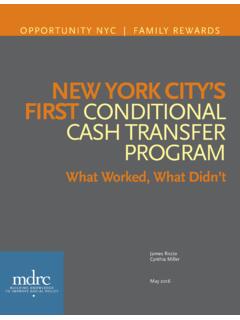Transcription of Serving Out-of-School Youth Under the Workforce …
1 Serving Out-of-School Youth Under the Workforce innovation and opportunity Act (2014) Farhana Hossain The federal Workforce innovation and opportunity Act (WIOA), signed into law in 2014, is the first ma-jor update in nearly 15 years to guide how the public Workforce system helps job seekers access educa-tion, training, and employment. Compared with its predecessor the Workforce Investment Act of 1998 (WIA) the new law puts greater emphasis on Serving Out-of-School Youth through training and services that are employer driven and linked to labor market demand. WIOA defines Out-of-School Youth as 16- to 24-year-olds who are not attending any school and who have one or more barriers to employment, such as young people who are homeless, are parenting, have disabilities, or have a juvenile or criminal This report draws upon available research and the MDRC staff s on-the-ground experience to summarize existing knowledge that can guide implementation of key WIOA provisions on Serving Out-of-School Youth .
2 It is organized in four sections: The first two sections focus on strategies for reaching and engaging a greater number of Out-of-School Youth , especially those who are most vulnerable; the third section re-views evidence on career pathway programs; and the final section discusses strategies for engaging pri-vate sector employers in job-related initiatives for Youth . Reaching and Engaging Out-of-School Youth WIOA requires that a much higher percentage of available state and local Youth funds go toward Out-of-School Youth 75 percent versus 30 percent Under WIA and increases the age range for Out-of-School - Youth eligibility to 16 to 24, from 16 to 21. States and local areas must incorporate strategies for recruiting and Serving more of these young people than ever before. A large portion of Out-of-School Youth who are not working those often referred to as disconnected or opportunity Youth are involved to some extent with public systems, such as welfare services, fos-ter care, and the juvenile or criminal justice systems.
3 They often seek services from community-based public and private organizations. In recent MDRC evaluations, including a national evaluation of Youth -Build, Youth training and employment programs have reported partnering with community-based provid-ers such as child welfare agencies, social service organizations, group homes, probation or parole officers, and even the local schools, to catch at-risk young people before they become While a majority of the Out-of-School Youth seek out opportunities to connect to training and work, Youth programs often report difficulties in sustaining participation after the initial connection is made. WIOA-funded service providers will not only have to reach more Out-of-School Youth , they will also need strate-gies to stimulate sustained, intense engagement in services. 1 United States Department of Labor, Employment and Training Administration (2015). 2 Wiegand et al.
4 (2015). June 2015 2 Past studies indicate that young people are more likely to engage when the following elements are present:3 Financial incentives and opportunities for paid training and work. Incentives and stipends are a key form of positive reinforcement to sustain motivation, especially when tied to bench-marks such as earning academic credentials or acquiring specific competencies. They also can be an important source of support to meet the economic challenges these young people But re-cent evaluations suggest that the quality of the work experience may also matter. Low-wage work th at is not connected to a career pathway or that young people perceive to have no value may not be as effective as work experience that gives them a sense of future advancement or the satisfac-tion of providing a needed service to the community. For example, a 2014 MDRC survey of more than 100 YouthBuild program directors found that working on construction projects in the com-munity offers young people the experience of producing something of tangible value, often for the first time in their lives, and is a motivating experience for young people even if they do not pursue a career in (A majority of YouthBuild programs provide construction train-ing whereby participants work on affordable housing projects.)
5 Opportunities to feel connected to caring adults and to a community. Many Out-of-School Youth experience instability in their family and neighborhood and lack adult support and supervi-sion. The presence of caring, committed adults who provide moral and emotional support appears to be an important feature of successful Youth programs, as is creation of a family-like atmos-phere and a sense of A scan of implementation literature points to a few factors that may assist in building such an environment and relationships: o Some programs say that enrolling young people in a series of small cohorts, as opposed to admitting them on a rolling basis, can encourage engagement by facilitating peer relation-ships and feelings of community. o Staff retention is key, as turnover among staff members whom participants have come to trust and rely on can be disruptive to engagement during the program, as well as during the follow-up period.
6 A manageable caseload and competitive salaries are obviously necessary to mini-mize staff burnout; regular communication and feedback from supervisory staff members and professional development opportunities are also important. o Staff members at Youth programs often emphasize the importance of shared experiences and similarities including race or ethnicity, family backgrounds, and life choices and conse-quences in building lasting connections with young people. Some programs encourage hiring staff whose socioeconomic and community backgrounds reflect those of the young people they serve, and programs may fo rmally or informally involve graduates in provision of services. Support services that address a young person s barriers to participation. o Transportation is one of the most often mentioned issues when it comes to providing services for young people. Most at-risk young people in urban areas rely on public transportation, so 3A summary of some of the most reliable research on job-related programs for Youth is attached.
7 4 Hossain and Bloom (2015). 5 Ferguson, Snipes, Hossain, and Manno (2015). 6 Hossain and Bloom (2015). 3 the programs need to be in accessible locations, and many provide subsidies; for young peo-ple in rural areas, transportation is a much bigger hurdle. For those who are parents, child care is also a common barrier. Given that Out-of-School Youth are a heterogeneous population with a range of experiences and skills, it may be important to take an individualized approach to addressing their personal barriers; however, no one program can directly meet all of a young person s needs. Partnerships with other agencies and programs can be key to meeting these needs, as long as those services are available in the community and young people can access them easily. A recent process study of Job Corps found that higher-performing centers had partners for outreach and career services that were colocated with the o In recent years, Youth programs have also reported seeing increased developmental and men-tal health needs among the disconnected and disadvantaged young people they serve.
8 These young adults face many threats to their social-emotional development such as family or housing instability, neighborhood violence, and abuse that can negatively affect their abil-ity to successfully engage in education and employment activities. Case managers and Youth counselors have reported using evidence-informed practices, like trauma-focused cognitive behavioral therapy and motivational interviewing, to address participants mental health needs; many programs also establish partnerships with local mental health providers for more intensive clinical therapy. In a recent experimental evaluation by MDRC, a program for young adults with histories of foster care or juvenile justice custody in Tennessee improved employment, earnings, housing stability, and mental health symptoms among participants af-ter one year. Case managers of the Youth Villages transitional living program worked one-on-one with a small caseload of young people, providing individualized and clinically focused counseling and case management to address their barriers in different areas and to connect them to available resources in the Engaging the Most Vulnerable Out-of-School Youth Very few programs target the young people who are the most persistently disconnected, and there is not much evidence on what works in engaging them.
9 Many programs prefer to work with the most motivated participants in order to meet performance standards set by funders, and therefore they use extensive screening processes to recruit participants. A significant share of Out-of-School Youth do not enroll in edu-cation and training programs because they have been alienated from mainstream institutions, like schools and social welfare agencies, due to earlier negative experiences. New strategies to reach and engage al-ienated and disaffected young people should be a priority. Some programs like Roca, United Teen Equality Center, Safe and Successful Youth Initiative, and Larkin Street are using street outreach teams to locate the most at-risk young people in their commu-nities and connect them with a host of supports, including employment and education services. While there is yet no rigorous evidence on how effective these programs are in improving education and em-ployment-related outcomes for Out-of-School Youth , they share a few common features with the previous-ly mentioned Youth Villages transitional living program, which improved employment and earnings among a foster care and juvenile justice population in Tennessee in an experimental study.
10 These features include intensive case management and one-on-one assistance from a caring adult to help young people navigate their barriers and the use of trauma-informed, evidence-backed behavioral interven-tions to increase participants motivation and skills to deal with life challenges (for example, coping skills to manage high-stress situations in a family or work environment). 7 United States Department of Labor (2014). 8 Valentine, Skemer, and Courtney (2015). 4 As mentioned above, many programs screen for motivation, which often entails employing a multistep enrollment process that requires participants to travel to the program or engage with the staff on a number of occasions. If young people cannot follow through with all the steps, programs interpret this to mean that they are not motivated or ready for the program. This approach runs counter to theories behind be-havioral economics, which posit that humans cognitive resources are limited and can be overwhelmed.
















